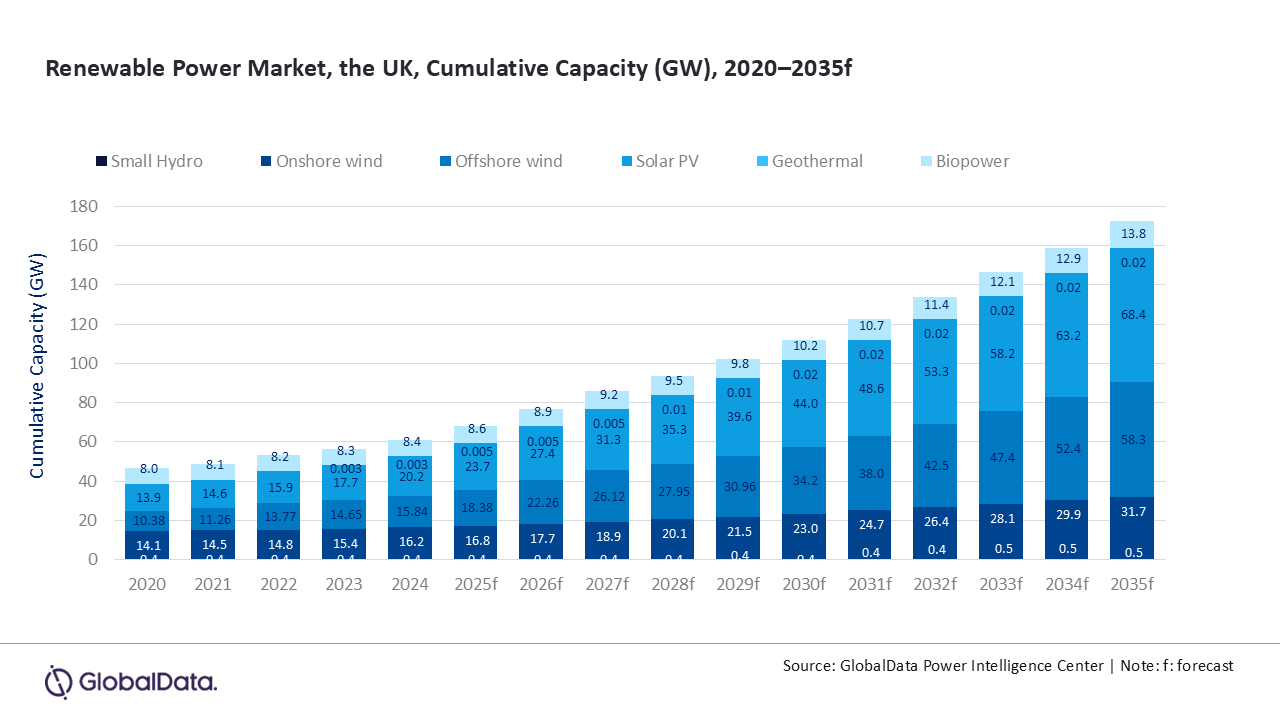The UK is scaling up renewable energy deployment at an accelerated pace, driven by strong policy support, large scale offshore wind expansion, and sustained investment in solar PV and biopower. The country’s cumulative renewable power capacity is forecast to reach 172.7GW by 2035, up from 61GW in 2024, registering a compound annual growth rate (CAGR) of 9.9% during 2024–35, according to GlobalData, the data and analytics company.
GlobalData’s latest report, United Kingdom (UK) Power Market Trends and Analysis by Capacity, Generation, Transmission, Distribution, Regulations, Key Players and Forecast to 2035, says that wind power will remain the dominant growth driver of the country’s renewable mix. Offshore wind capacity is expected to surge to nearly 58.3GW by 2035 from 15.8GW in 2024, supported by the Clean Power 2030 mission, successive Contracts for Difference (CfD) auction rounds, and large-scale grid expansion projects across the North Sea. The UK’s offshore wind pipeline is among the largest globally, strengthened by floating offshore wind projects, port infrastructure investment, and manufacturing localization efforts in regions such as Teesside, Humber, and Scotland.

Onshore wind in the UK will also expand strongly from 16.2GW in 2024 to 31.7GW in 2035, aided by the government’s decision to lift previous planning restrictions and accelerate approvals for repowering and hybridization. Solar PV is projected to rise from 20.2GW in 2024 to 68.4GW in 2035, supported by CfD backed utility scale projects, commercial rooftop deployment, and community energy initiatives. Biopower will continue to play a stabilising role, increasing from 8.4GW to 13.8GW, leveraging the UK’s circular economy initiatives and sustainable waste to energy policies.
Mohammed Ziauddin, Power Analyst at GlobalData, comments: “The UK’s clean energy growth is being powered by a robust framework that includes the CfD mechanism, the Clean Power 2030 mission, and the Net Zero Strategy, all providing long term policy stability and investment certainty. Infrastructure programs such as National Grid’s £35 billion ($44.4 billion) transmission upgrade plan and the Eastern Green Links offshore superhighway are further enabling large scale renewable integration and regional balancing.”
The report highlights that while nuclear capacity growth is set to slow in the near term, declining from 5.9GW in 2024 to around 4.1GW by 2035, thermal gas will continue to play a crucial role in ensuring system reliability and balancing renewable generation. Gas fired plants will remain an integral part of peak demand management and supply security as storage and hydrogen capacity gradually expand.
Government initiatives such as the £14.2 billion ($19.1 billion) Sizewell C investment and the Great British Nuclear program for small modular reactors (SMRs) will sustain low carbon baseload generation and complement the rapid growth of renewables.
Zia concludes: “Offshore wind will be the centerpiece of the UK’s clean energy expansion, supported by record investment, policy stability, and grid modernisation. With solar, onshore wind, and biopower contributing to diversification, the UK is well positioned to maintain momentum toward a low carbon power system and achieve its 2050 net zero goal.”
 Engineer News Network The ultimate online news and information resource for today’s engineer
Engineer News Network The ultimate online news and information resource for today’s engineer


